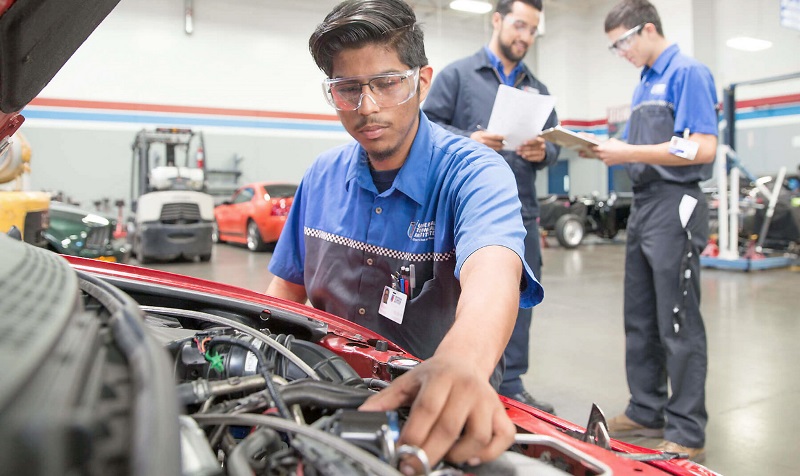
ADAS, automatic e-braking, exit warning systems, and automatic emergency braking all make driving safer. These features can be found in your car's manual. ADAS, or advanced driver assistance systems, help vehicles avoid obstacles and pedestrians, and are becoming increasingly important as cars become more advanced. Which car technologies are worth your investment? Read on to find out which ones really add value to your driving experience.
Warning system for exit
Ford engineers are currently working on a new mechanism to prevent the vehicle's doors from opening until they are clear of danger. The mechanism can be manually overridden if the occupant wishes to remain in the vehicle. Ford is also testing the Exit Warning System on cyclists as well as drivers on different road layouts. The Exit Warning system is likely to be added to new Ford models once it has been proven effective.

Smart control
The latest innovations in car technology are autonomous driving and smartcruising. These features are great for reducing driver fatigue but can also pose a problem. In bad weather, they can become unresponsive and lose their focus. Before purchasing a smart cruise control system, drivers should review reviews from other users and compare features. Adaptive cruise controls can adjust your speed to match traffic conditions. Other systems will only slow you to a specific level and offer limited steering assistance.
ADAS
ADAS or advanced driver assist systems are one of the biggest innovations in the automobile industry. They enable drivers to control their vehicles better and reduce their risk of accidents. ADAS consists of a series of sensors and interfaces that are connected to a powerful processor. Those computers are constantly analyzing the environment around the vehicle, and prioritize the information to take action or take no action at all. ADAS systems help prevent accidents and will eventually make cars fully autonomous.
Digital cockpit
Today, we can find the latest in automobile technology in our cars. We can make better decisions while driving by using digital instruments and dashboard. The digital instrument panel integrates several features like front, rear, and side cameras to help us see while driving and remain safe. These systems also use sensors to prevent accidents and warn us of hazards. These technologies can make driving safer, help avoid accidents, and even save fuel.
Connectivity to your smartphone wirelessly
Many automakers are still not embracing wireless connectivity as a way for customers to stay connected to their cars. Apple and Google have almost perfected human-car connectivity. CarPlay and Android Auto allow drivers to interact with their smartphones through the touchscreen. The growing number of state laws that allow touchscreen interaction are being met by voice-operated commands, as well as the ability to reject or accept incoming calls.

Navman Move120M
A GPS system is a great investment for young drivers. The Navman MOVE120M will notify you of red-lights and speed cameras. It can also help you find your way to home or the nearest station. A dash cam is a great idea for young drivers. These devices can help in situations where they might not be aware they are speeding.
FAQ
What does it matter which college I attend?
You're wrong. There is no difference between colleges in terms of how to get into the automobile industry. There are some schools that offer more specific programs than others.
What kind of car mechanic jobs exists?
There are three main areas of employment for car mechanics:
-
Automotive repair shops
-
Dealerships
-
Independent garages
Automotive repair shops
This is where most people consider becoming a mechanic. This is the best way to get started. You can either work in a shop run by someone else, or start your business.
If you plan to work in a shop, you must apply to join the union. Once you're accepted into the union, you'll receive training from the union.
After completing the training, you'll be ready to start work.
If you plan to open your own garage you will need to register with government. You'll need to meet certain standards after you register.
When you've registered, you'll be given a license to operate your garage.
Your license will allow you to sell spare parts and do minor repairs. It will not permit you to fix major engine issues.
You will be expected to sell spare parts and also offer guidance and advice to customers.
Dealership jobs
Most dealerships employ mechanics who can specialize in a particular area of the car. They might be able to only fix brakes or replace tires.
Some dealerships hire general mechanics to handle all aspects of car repair.
These positions often require applicants to undergo specific training before being allowed to work. Employers can then choose the best candidates for their job.
Some dealerships hire students straight out of college. These graduates already know the basics of mechanical engineering and therefore have no problem learning about cars.
Independent garages
Independent garages aren't associated with any particular dealership. They are more focused on providing top-quality service.
Independent garages are not associated with any companies so they can afford higher wages. As a result, these jobs are generally better paid than those at dealerships.
But this doesn't mean that independent garages are necessarily better places to work. Many owners prefer to control their businesses themselves, rather than delegating it to employees.
This could lead to you working long hours with little control over your day.
It is also possible to expect lower wages than you would if working at a dealer.
The good news is that you can easily switch between different kinds of jobs. To work at a dealership you will need to contact your employer to see if he is open to the idea of hiring you.
You could also apply directly to an owner of a garage if that's what you want.
The bad news is that finding a new job isn't always easy. There are many factors that affect how much you make.
It could be the type and cost of labor you use to repair your vehicle.
Is it hard to be an apprentice mechanic?
It is not easy but it can be done quickly. There are many opportunities for advancement.
You must be patient and persistent. You should also be able to repair cars, trucks, and motorbikes.
Customers and family members will put pressure on your shoulders to help you succeed. You shouldn't feel pressured to make decisions that you don't like.
This could be an excellent career choice for someone who enjoys fixing cars. It's a job where you can earn a decent salary and build up your business.
You might choose to take a different route. You might consider becoming a technician in this instance.
This means that you can use your technical knowledge to help other workers. Technicians could benefit from your technical expertise to solve problems or teach new techniques.
Another option is to be a service advisor. Here, you'll provide advice and assistance to customers when they bring their cars to a garage.
The decision you make will depend on what you are looking for. There are plenty of options available, and you can choose which suits you best.
What is the length of an automotive training course?
An automotive course is three years long.
The first year focuses on theory and learning about cars. The second year is spent on practical training where you learn how to drive, fix engines, and do other mechanical jobs around the car. You will spend the final year working in a local garage to gain real-world experience.
How do I prepare for a mechanic apprenticeship?
It is important to have an understanding of what you are going into. It is important to know the basics of how cars work. This will allow you to be prepared for your first day at work.
You will also need to learn how to fix simple problems like tires and broken lights.
This will teach you how to diagnose problems and fix them yourself.
It is also important to know how the different pieces fit together in order to put them together again.
Finally, you should be able use tools safely.
These are all things that will make you a competent mechanic.
What are the qualifications for an automotive technician
You must have completed high school or GED with good grades in maths and English. You also need to be able to read and write well. Before you can start working, you will have to pass a written exam and take a series practical tests.
Statistics
- According to the BLS, the median annual salary for automotive service technicians and mechanics in the United States was $44,050 in May 2020. (uti.edu)
- According to the BLS, total auto technician employment is expected to exceed 705,000 by 2030. (uti.edu)
- Apprentice mechanics earn significantly less hourly than mechanics who have completed training, with a median wage of approximately $14.50 an hour, according to PayScale. (jobhero.com)
External Links
How To
How to correctly diagnose your vehicle for repairs
The symptoms of your vehicle are the first thing you need to look at in order to determine whether it is in dire need of repairs. These steps will help you diagnose your car properly.
-
Check engine lights. The dashboard light indicators, including the engine light, oil pressure gauge, battery light indicator, coolant temperature gauge and RPM gauge, should be checked. If they have been flashing for more days than usual, it could be a sign that something is wrong with the vehicle.
-
Pay attention to the treads on your tires. If the tires are worn out, they could cause problems with handling and braking. Also, inspect the treads of your wheels. They should be clean and smooth. The best way to do this is to remove the wheels and take them off. To check the condition of your treads, use a flashlight.
-
Monitor the level and consistency of your brake fluid. It is important to keep track of how much brake fluid you have in your car. This will ensure your brakes function properly. Low brake fluid levels could cause your brakes to fail when you apply pressure.
-
The suspension system should be tested. The suspension system in vehicles absorbs vibrations and shocks. This suspension system provides greater control and smoother acceleration and deceleration. A suspension problem can cause your vehicle to feel wobbly and shake uncontrollably. Try putting some weight on your front or rear axle to determine if you have a suspension problem.
-
Examine your steering column. The steering column connects the steering wheel to all other components of the vehicle. Sometimes, steering columns are damaged by accidents. If yours feels loose or shaky, you should replace it.
-
The exhaust pipe should be observed. Exhaust pipes help move gases from the combustion chamber to the atmosphere. Your cabin will be effected if your exhaust pipe cracks or leaks. Also, if your tailpipe is bent, you should fix it immediately.
-
Look under the hood. If you see anything unusual, take a look under the hood. You could have fluids leaking from the engine. You should also contact a professional technician if there is an unusual odor coming from the engine compartment.
-
Check the air filter. The air filter in your vehicle collects dirt and dust from the environment. Vehicles that have a dirty air filter will not run well. Replace your air filter regularly.
-
Verify the fan belt. The fan belt is the link between the engine and the transmission. If the fan belt fails, the engine won't start. It's easy to replace the belt. You will need a screwdriver, pliers and a pair of pliers.
-
Verify the radiator hoses. The radiator hose is used to carry water from the radiator to your engine. If the hose becomes damaged or cracked, hot liquid can be emitted onto the engine. The hose can be repaired with a pair or needle-nosepliers, and a wire brush.
-
Check the windshield wipers. Windshield wipers use electricity for snow and rain removal. If they stop working they could leave streaks behind on your window glass. Simply change the washer oil to fix the problem.
-
The battery cables should be checked. Your car's electrical system is powered by batteries. Make sure you disconnect the negative cable before replacing batteries. Failure to do so can damage your alternator.
-
Make sure your headlights are working properly. Headlights are used to illuminate the road ahead. They can make it difficult to see if they stop working. You can check the bulbs to make sure they aren't burned out.
-
Check the lights. The lights are there to warn other drivers if they approach you at night. You could be distracted and cause an accident if one does not work.
-
Check your brakes. Before you have a collision, brakes slow down your car. If they aren't working correctly, you could lose control of your car and crash.
-
Change the oil. Your engine will stay lubricated by the oil. It helps prevent metal parts from wearing out too quickly. It is recommended that you change your oil at least once per month.